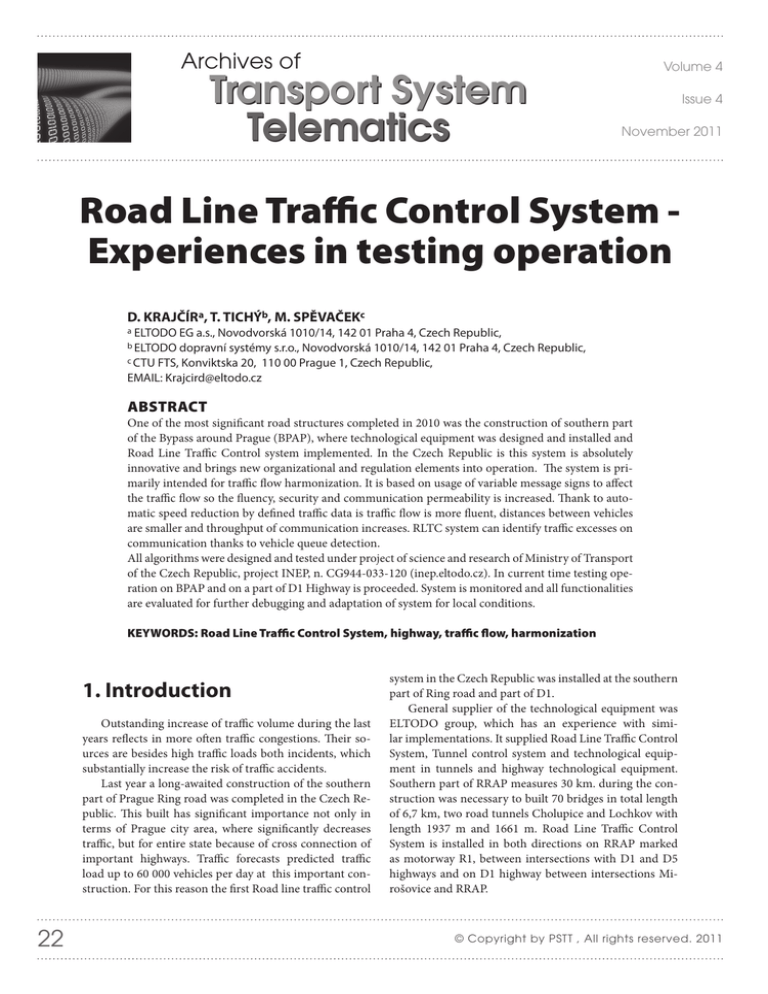
Archives of
Transport System
Telematics
Volume 4
Issue 4
November 2011
Road Line Traffic Control System Experiences in testing operation
D. KRAJČÍRa, T. TICHÝb, M. SPĚVAČEKc
ELTODO EG a.s., Novodvorská 1010/14, 142 01 Praha 4, Czech Republic,
dopravní systémy s.r.o., Novodvorská 1010/14, 142 01 Praha 4, Czech Republic,
c CTU
FTS, Konviktska 20, 110 00 Prague 1, Czech Republic,
EMAIL: Krajcird@eltodo.cz
a
b ELTODO
ABSTRACT
One of the most significant road structures completed in 2010 was the construction of southern part
of the Bypass around Prague (BPAP), where technological equipment was designed and installed and
Road Line Traffic Control system implemented. In the Czech Republic is this system is absolutely
innovative and brings new organizational and regulation elements into operation. The system is primarily intended for traffic flow harmonization. It is based on usage of variable message signs to affect
the traffic flow so the fluency, security and communication permeability is increased. Thank to automatic speed reduction by defined traffic data is traffic flow is more fluent, distances between vehicles
are smaller and throughput of communication increases. RLTC system can identify traffic excesses on
communication thanks to vehicle queue detection.
All algorithms were designed and tested under project of science and research of Ministry of Transport
of the Czech Republic, project INEP, n. CG944-033-120 (inep.eltodo.cz). In current time testing operation on BPAP and on a part of D1 Highway is proceeded. System is monitored and all functionalities
are evaluated for further debugging and adaptation of system for local conditions.
KEYWORDS: Road Line Traffic Control System, highway, traffic flow, harmonization
1. Introduction
Outstanding increase of traffic volume during the last
years reflects in more often traffic congestions. Their sources are besides high traffic loads both incidents, which
substantially increase the risk of traffic accidents.
Last year a long-awaited construction of the southern
part of Prague Ring road was completed in the Czech Republic. This built has significant importance not only in
terms of Prague city area, where significantly decreases
traffic, but for entire state because of cross connection of
important highways. Traffic forecasts predicted traffic
load up to 60 000 vehicles per day at this important construction. For this reason the first Road line traffic control
22
system in the Czech Republic was installed at the southern
part of Ring road and part of D1.
General supplier of the technological equipment was
ELTODO group, which has an experience with similar implementations. It supplied Road Line Traffic Control
System, Tunnel control system and technological equipment in tunnels and highway technological equipment.
Southern part of RRAP measures 30 km. during the construction was necessary to built 70 bridges in total length
of 6,7 km, two road tunnels Cholupice and Lochkov with
length 1937 m and 1661 m. Road Line Traffic Control
System is installed in both directions on RRAP marked
as motorway R1, between intersections with D1 and D5
highways and on D1 highway between intersections Mirošovice and RRAP.
© Copyright by PSTT , All rights reserved. 2011
D. KRAJČÍR, T. TICHÝ, M. SPĚVAČEK
Fig. 1. RLTC installation scope at R1 and D1
Currently, we already have more than a half year operation and functioning of RLTC system on
RRAP, thus in this article we can evaluate its first results.
2. Road Line Traffic Control
principle
level reduces accumulation of these waves together with
increasing communication permeability. At lower speeds spaces between vehicles are minimized which leads
to higher road capacity. The traffic flow harmonization is
assured by Road Line Traffic Control system by reducing
maximum speed using variable message signs (VMS) installed on control profile gantries, which are located on
regularly spaced locations. Further RLTC system detects
formation of vehicle queue and warns concerned drivers
against these drivers using VMS. Another important feature is warning against meteorological states inconvenient for traffic and based on dangerousness traffic flow
speed is reduced. In this case system collects data from
meteosensors on the highway, which are automatically
processed and evaluated. Of course there is a warning before accident, work or obstacle on the road, for example
debris or animals. In case of restrictions on driving in selected lanes it is possible to activate light arrow, which
ordered to leave the driving lane.
2.2 Control Algorithm
All algorithms were designed and tested under project of science and research of Ministry of Transport of
the Czech Republic, project INEP, n. CG944-033-120,
whose main solutionist is ELTODO group. During the
Road Line Traffic Control System (RLTC) was supplied for open route and cooperates closely with control
systems of both tunnels. Based on measuring traffic flow
parameters system affects flow fluency, increases communication permeability and security of traffic flow. Based
on timely provision of information drivers may adapt their driving way and substantially reduce the risk of traffic accidents.
2.1 Range of functions
In cases when the situation requires, variable message signs (VMS) with warning symbols, prohibitory signs
limiting maximum allowed speed or prohibiting drive of
trucks outside of right lane are displayed on control profiles of RLTC system. Important parts of each control profile (RLTC Gantry) are detectors measuring volume, speed,
traffic flow composition and other parameters. Based on
these data system is able to perform these proceedings automatically, without system operator intervention.
Thanks to RLTC system it is possible to extend highway capacity during the peak hours and reduce creation of
congestions, which often causes traffic accidents. During
high traffic volumes “Stop and Go” waves occur, which are
typical with high differences in speeds in the downstream sections. Consolidation of these speeds on the same
Volume 4 • Issue 4 • November 2011
Fig. 2. Active RLTC gantry on RRAP (R1)
Fig. 3. Schematic principle of Road Line Traffic Control
functionality
23
Road Line Traffic Control System - Experiences in testing operation
Information between these systems must be shared with
regard on a good coordination of all precautions.
Road line traffic control system is connected to newly
constructed supervisory centre SSUD Rudná, where proceeds uninterrupted surveillance of the completed part of
the Prague ring road. Systems are monitored and during
test operation are adjusted for having most fluent and safety traffic.
3. Results from operation
Fig. 4. Volume and speed evaluation included adjustment of
maximum allowed speed from 24th February 2011 on RLTC
Gantry on R1 17 km right
traffic solution design algorithms were applied on particular conditions and in some cases were modified based on
experiences from real operation.
Together with algorithms for evaluation of untypical
traffic states was necessary to develop principles of application of single action on multiple sections simultaneously. Traffic precaution is applied on one particular
profile or a group of profiles, but during operation there
are situations, when it is necessary to combine more precautions together with preserving the rules of reducing
speed on highways and avoiding to display speed steps on
subsequent profiles. In order to avoid step changes of speed, which has negative influence on flow fluency, special
smoothing algorithms were developed. Smoothing algorithms manage displayed symbols in consecutive profiles
with regard to exact profile location on the route.
Finally, it is necessary to activate the maximum speed
limits in time shifts instead of simultaneously. This provides so-called dynamic sequences, which reduces speed on
requested level in the shortest time so that drivers actually
moving on route are not forced to slow down sharply on
low speeds. RLTC system doesn’t forget on extreme event
of driving in inverse direction. Although this is not very
frequent, but may have fatal consequences. In case of detected inverse driving event, RLTC system automatically
reduces speed on its minimum and displays warning on
traffic signs including information transmission in information gantries close to event occurrence.
Road line traffic control system, thanks to which is Prague ring road often called “Intelligent highway” is closely
linked to traffic states of both tunnels located on the route
of RRAP. Besides smoothing maximum allowed speeds
on open route and inside tunnels there exist connections
for traffic restrictions inside tunnels, which have significant influence on operation on open route and backwards.
24
RLTC system is in operation more than half year and
during this time its function is very carefully controlled
and results are examinated by representatives of both
the National highway provider (ŘSD) and by our company. With regards to complexity of system and quantity of its functions number of parameters can be evaluated.
3.1 Traffic harmonization
Main parameters for traffic flow harmonization are
speed and traffic volume. These parameters are showed in
Fig. 4. RLTC system functionality is clear from upper bold
red line, which shows adjustment of maximum allowed
speed in time. From traffic volume graph is nicely visible
day flow including morning and afternoon peak hours.
Because of high traffic volume before eight o’clock was
during morning peak hours the maximum allowed speed
was reduced to 80 km/h and after volume decrease at 8:30
a.m. was increased.
From further detail speed evaluation in driving lanes
explicitly results, that most of drivers respect actual traffic notation on VMS and differences between lanes are
minimal. This is apparent from speed flow showed with
orange spline in Fig. 4. Traffic is effectively homogenized and beyond ensuring smooth traffic flow and extended
road capacity the risk of traffic accidents is substantially reduced. 3.2 Emergency situations
During the system operation also such situations
happened, when system reacted to occurred situations
much earlier than surveillance operator, who is warned on
exceptionalities by this system. It sometimes happens, that
drivers are forced to react to small traffic accident event
by speed reduction. RLTC system automatically detected
and evaluated this accident and slowed down traffic both
on profile close to accident and on previous profiles. Operator both reacted to this state by finding accident source
thanks to video surveillance by sending police patrol to
the accident and supplemented speed symbol on gantry
Archives of Transport System Telematics
D. KRAJČÍR, T. TICHÝ, M. SPĚVAČEK
profiles by warning symbol on VMS. Thanks to this proceeding risk of another accident was substantially reduced
by preserving traffic flow continuity and speeded up liquidation of incurred situation.
4. Conclusion
Although the RLTC system is brand new issue in
the Czech Republic, despite the generally lower respect of
Czech drivers on VMS road signs, we can see its big benefits. Homogenization of traffic flow by speed limits is
explicitly positive and risk of traffic accident is further
reduced by activating warning symbol on VMS. An important factor influencing the proper system functionality is operator, who confirms selected events and sets
other setting directly into the system. Overall, we can
say, that system performs its function, and significantly contributes to rising traffic flow fluency and safety.
The trend of steadily increasing traffic volumes, both financial and time-consuming constructions of new highways, and finally increasing demands for transport
security, we can assume, that telematics systems for increasing throughput and safety of routes will continue to be
developed and improved.
Volume 4 • Issue 4 • November 2011
Biblography
[1] KRAJČÍR D., ŠŮSTEK M., KŇÁKAL M.: Projekt
systému SOKP, D1 Liniového řízení dopravy, ELTODO EG, a.s., Praha, Česká republika, 2010,
[2] KRAJČÍR D., ŠŮSTEK M.: Pražský okruh přinese
úplnou novinku v řízení dopravy, Dopravní noviny,
Praha, Česká republika, 29. července 2010, str. 8,
[3] ŠŮSTEK M.: Řízení dopravy na liniových komunikacích, Silnice Železnice, Praha, Česká republika,
3/2009, str. 30-31,
[4] ŠKODÁČEK M., KŇÁKAL M.: Bezpečnostní systémy na Silničním okruhu kolem Prahy, SILNICE
ŽELEZNICE, Praha, Česká republika, 1/2011, Příloha XXIV,
[5] TICHÝ T., KRAJČÍR D.: The Conception Approach
to the Traffic Control in Czech Cities – Examples
from Prague, 10th Conference, TST 2010, Katowice
– Ustroň, Poland, 2010, str. 410-407,
25




